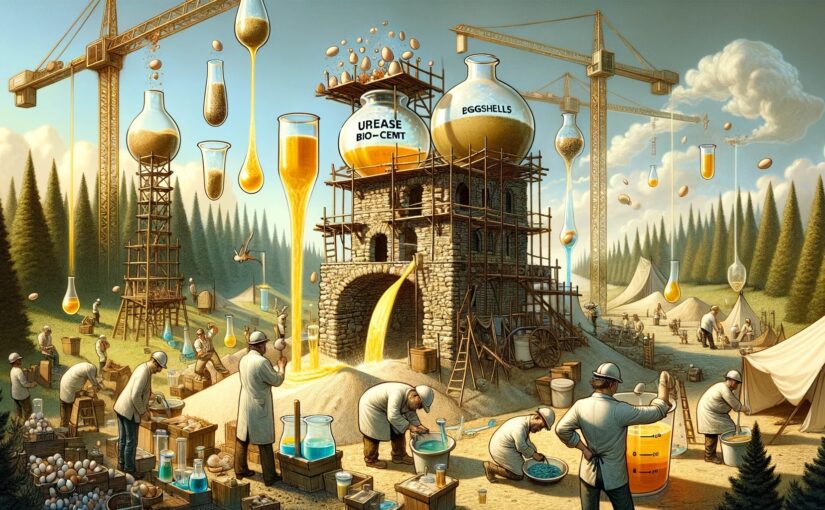In the not-so-distant past, the idea of turning everyday waste into a building material might have sounded like science fiction. Fast forward to today, and welcome to the crazy idea of urease bio-cement, where the line between science fiction and reality blurs in the most unexpected ways. Let’s look into the fascinating alchemy of modern science.
The Unlikely Heroes: Urease, Urea, and Calcium Chloride
At the heart of our story are three peculiar characters: an enzyme named urease, a waste product we diplomatically refer to as urine (yes, pee!), and a compound known as calcium chloride, which, contrary to what its highfalutin name might suggest, is as mundane as the salt sprinkled on icy sidewalks.
Urease: The Enzyme
Urease, our first protagonist, is an enzyme that’s been hiding in plain sight, biding its time in microbes and plants, eagerly waiting to show off its ability to break down urea. And when it does, oh boy, does it create a scene—splitting urea into ammonia and carbon dioxide.
Urea: From Pee to Pillars
Next up is urea. Now, before you scrunch up your nose, consider this: urea is not just a waste product; it’s a recycling marvel waiting to happen. Found abundantly in urine, it’s the secret ingredient our enzyme friend needs to kickstart the bio-cementation process. And while the thought of collecting urine might not seem appealing, it’s a testament to human ingenuity’s ability to find value in the most unexpected places. As a matter of fact, some old construction materials were already mixed with urine.
Calcium Chloride: The Ice Melter That Binds
Last but not least, calcium chloride makes an entrance. This compound, which might seem more at home in a road crew’s toolkit than in construction, plays a crucial role in our story by reacting with the products of urease’s hard work to form calcium carbonate—a substance as close to natural cement as you can get without a mixer truck.
Brewing the Bio-Cement: A Recipe for the Brave
Now, let’s get down to the nitty-gritty: how do we turn these ingredients into bio-cement? Imagine, if you will, a sandbox. But instead of sandcastles, we’re aiming for something a tad more permanent.
- Prepare the Aggregate: Think of this as laying out your ingredients before baking a cake, but instead of flour and sugar, you have sand or any other aggregate that needs a touch of solidity.
- Mix the Solution: Dissolve urea (yes, the refined version of our pee) and calcium chloride in water. It’s like making lemonade, but please, don’t take a sip!
- Add Urease: This is where magic happens—scientific magic. The urease dives into the solution, breaking down urea at breakneck speed.
- Application: Pour this bubbling brew over your aggregate, and watch as it begins to transform before your eyes, binding the particles into a solid mass.
- Curing: Like waiting for the dough to rise, this step requires patience as the bio-cement hardens, turning your sandbox experiment into a rock-hard reality.
A Twist in the Tale: Pee and Eggshells?
But what of our quest for natural sources? Can one truly stroll into their backyard, collect some urine and eggshells, and start a construction project? Well, not exactly, but almost. While urine offers a readily available source of urea, eggshells, and bones, rich in calcium carbonate, suggest a more roundabout route to sourcing calcium.
Unfortunately, converting eggshells into calcium chloride might not be as simple as making a morning omelet (and involves a bit more chemistry than most kitchens are equipped for), but it embodies the spirit of innovation and sustainability. Think of it as giving new life to leftovers, a culinary challenge for the eco-conscious builder.
Building a Better Tomorrow, One Odd Ingredient at a Time
It is a crazy transformation that turns the ordinary into the extraordinary, where pee and eggshells aren’t just waste products but the building blocks of tomorrow. In urease bio-cement, every ingredient tells a story of potential and promise. This reminds us that sometimes, the most groundbreaking solutions come from reimagining the world around us.
In closing, remember that the next time you flush away some valuable urea or toss out an eggshell, you might just be discarding the foundation of the next architectural marvel. In the end, it’s not just about building materials; it’s about building a mindset where nothing goes to waste, and everything has potential. Welcome to the future—it’s weirder and more wonderful than we could have ever imagined.
